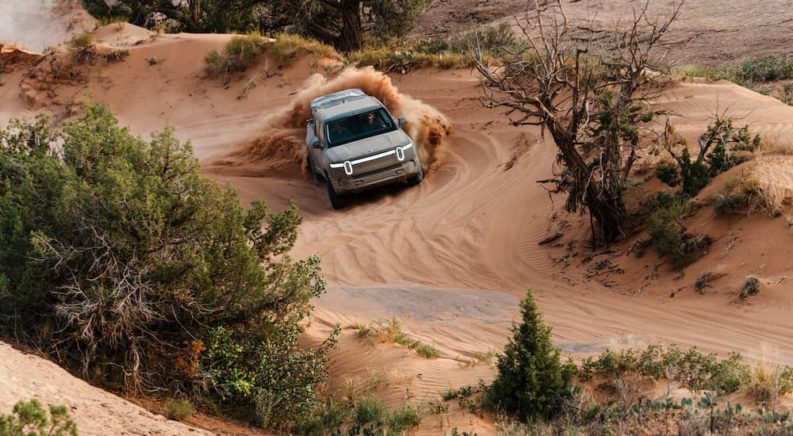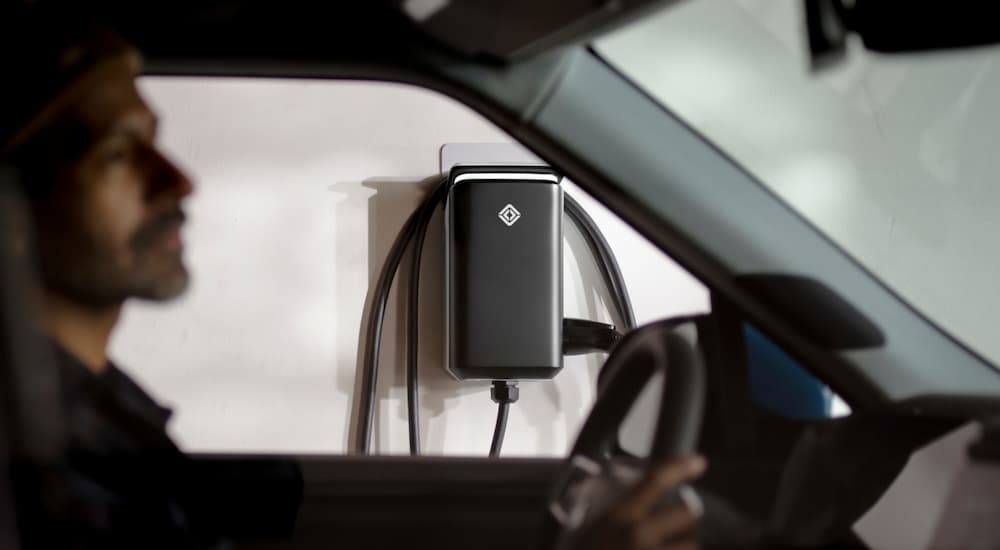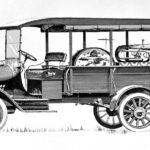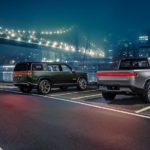It really doesn’t take much effort to spot one—Rivian’s signature headlight design, along with the lightbar that arguably started an industry-wide trend, makes it easy to ID at any time of day. It stands out in real life just as much as it does on camera, which I realized when an R1T in First Edition livery flashed past on a New York highway. Despite all barriers, the harrowing path of a start-up, the pandemic-driven supply chain struggles, and the PR fiasco of raising prices two years after announcing them (and then walking that back for early adopters)—Rivian is here, and they seem to be here to stay.
The R1T’s production cycle is barely underway but the truck has already made waves, earning Motortrend’s 2022 Truck of the Year award and permanent status as the first electric truck to market in the 21st century. Automotive YouTube is in love with it, and it’s easy to see why, despite its drawbacks. Small enough to handle its weight but big enough to handle most day-to-day pickup duties, with high-end accouterments, sports car acceleration, and Wrangler-like off-road capabilities, the R1T may be the ultimate modern American vehicle. And thanks to the 2022 release of the R1S SUV, the hype surrounding the first electric pickup platform is liable to carry on right through 2023.
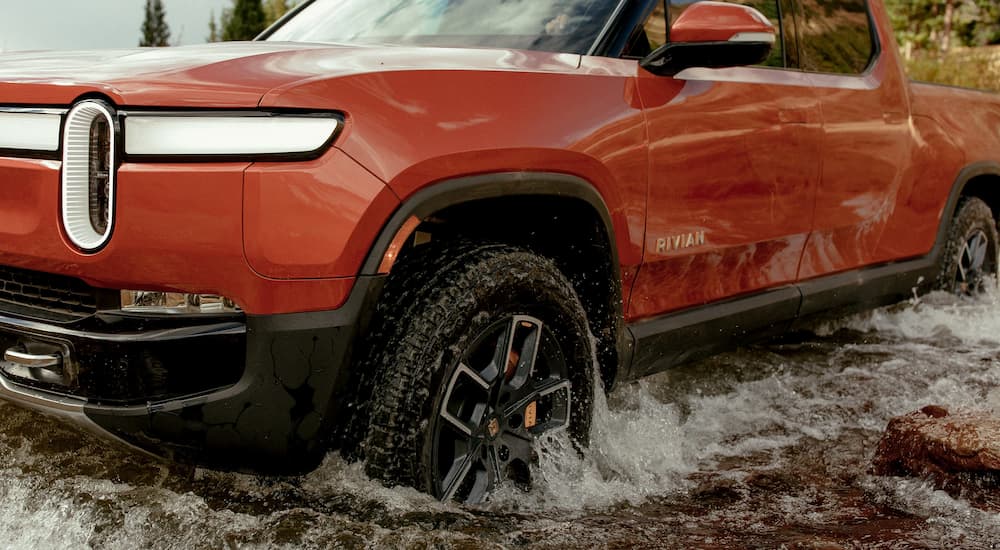
Undefined by Its Benchmarks
Trying to pin down Rivian’s identity is similar to trying to describe Tesla from a decade ago. There’s an overwhelming sense of “everything, all at once” about how it differentiates from all reasonable competitors. I mean, I’ll knock off the Wrangler comparison right here—it might be too big to do everything 2-door Wranglers can, but Rivian has proven that their platform can hang with many Jeeps, and it can actually tow worth a damn in the process (more on that in a moment).
The best comparison for the R1S might be the Tesla Model X, another top-of-the-line electric SUV—but then again, it might not be. The Model X costs tens of thousands more, and though it has access to the Tesla Supercharger network and gets more range, the increase isn’t that much (351 miles vs. 316 miles for the R1S), and that’s about the only advantage there is! The R1S decimates Tesla’s towing cap (7700 lbs vs. 5000 lbs), seats 7 in 3 rows vs. 5 in 2, and with a standard ground clearance of 8” vs Tesla’s 5.4”, it’s actually capable of off-roading. In short, it’s a genuine full-size SUV—whereas the Model X is a super-premium crossover.
When it comes to cargo area, the Model X looks like it has Rivian beat—until you fold the third row of seats down and the R1S becomes the more capable vehicle. However, the Chevy Suburban is a comp that doesn’t compromise between seating and cargo, with a larger cargo hold than even the Tesla’s at 41.5 cu.ft. The R1S and Suburban make another interesting comparison—it’s a real testament to GM engineers that the latest Suburban and Tahoe are so spacious when the wider, taller R1S doesn’t have any mechanical drivetrain components to squeeze into the packaging. They both have more interior cargo room than the Rivian (even the Tahoe is 10” longer) and the Tahoe can tow 700 lbs more, all for the same discount vs. the R1S that Rivian offers against the Model X.
If your interest is in a family-hauling SUV and an EV powertrain’s only purpose for you is to save on fuel expenses, then the Rivian looks like a hard sell. But Chevy doesn’t offer a powertrain with more than 420 hp—the R1S makes 835! Rivian’s 9 driving modes and adaptive air suspension (giving it up to 15” of ground clearance) make it a supreme overlanding vehicle, and the R1S makes up its cargo deficit to the Tahoe with a 11.1 cu.ft. frunk—big enough that without folding any seats down, the Rivian’s capacity is actually larger!
The net result is a 3-row electric SUV that competes for spaciousness with the Tahoe; for capability with Suburban; for speed and agility with the Model X; and, to say it one last time, for off-roading prowess with the Wrangler Unlimited. The uniqueness of that combination is what got people so excited about the R1T and is exactly why I think we’re going to stay excited for the R1S. Well, that, and all the other cool stuff that goes along with the Rivian brand.
A Serious Change in Scope—Recharging a Rivian
There’s a lot that goes along with creating a family-friendly daily driver that’s also among the best off-roaders of its type—and, by the way, is entirely battery-powered. A key part is the charging experience, which is reportedly a Rivian weakness today. With no massive independent infrastructure brands supplying the means to support a nationwide fleet of EVs, manufacturers have had to take it upon themselves. You’ve heard of Tesla’s supercharger network, and Jeep is putting up chargers for the 4xe series vehicles—and Rivian is no stranger to this game. They’ve been developing all of the hardware and software in-house for their own national charging network to meet the needs of R1S and R1T drivers.
It seems weird, doesn’t it? Like, if you could only fill up your Toyota at Toyota-brand gas stations, and getting an Audi in the boonies was a bad idea because where could you go to fill it up? But that’s almost what it’s like to be driving an EV, though public infrastructure is increasing (and the option to charge at home is universal). My guess is that it’ll take a few years for each EV manufacturer to complete the construction of enough stations for a more standardized architecture to take hold, enabling EV drivers the same freedom of choice as gas guzzlers.
Until then, however, we need the Rivian Adventure Network up and running. Good thing they’re working on it! 600 sites nationwide (by the end of 2023) is fewer than it sounds, but with 3500 DC chargers split between them, they’ll make a sizable dent in the gap that exists today.
The impact will be compounded by strategic placement and design that runs counter to tradition, like nearly everything else about Rivian. Large spaces to accommodate full-size vehicles, and a pull-through spot at every station for vehicles pulling trailers, will provide the room that electric overlanders need to refuel with convenience. The tiny EVs of yesterday simply didn’t demand that kind of infrastructure, so it’s on Rivian to deliver something new!
Similarly, it wasn’t really until the Rivian R1 platform and Wrangler 4xe that there was any real need for charging stations near trails and other adventure-oriented locations. These lifestyle-focused EVs have changed that situation entirely—which is why the first three Rivian Adventure Network stations are placed in Salida, Colorado along the Arkansas River and along US 395 in California, providing electrified access to Death Valley and Yosemite. They’re not exactly places you’d expect to find a LEAF, so Rivian is stepping up to fill in the gap.
The R1S Is Meant to Go There
Make no mistake, Rivian fully expects their customers to take their R1T and R1S EVs all the way out to national parks and wilderness zones like those, pushing the battery ranges to their absolute limits. That’s why they’re not only creating charging infrastructure in remote areas, but they’ve also designed a total of NINE (9) driving modes, so far, to take advantage of every Rivian’s technical capabilities.
Sure, they started with 8 (as many as the Bronco’s G.O.A.T. modes), but thanks to the magic of over-the-air (OTA) updates—a revolutionary, if controversial, capability pioneered by GM with OnStar and rapidly becoming commonplace on vehicles of every type—they now have 9, which I think is an industry-leading figure. There are enough of them that Rivian posted a video dedicated to demonstrating how the suspension and powertrain behavior changes to accommodate the conditions you’re driving in. The ride height, suspension stiffness, regenerative braking strength, stability control aggressiveness, and torque distribution are all modulated to favor efficiency, traction, or speed—both on and off the beaten path.
The 9th drive mode is called Soft Sand, perhaps Rivian’s equivalent to Baja mode but with more of an emphasis on not getting stuck than on screaming over the dunes at 80 mph. No longer will you be an instant meme for getting stuck on the beach! On the one hand, it seems like a gimmick, but truthfully, the activities of sand driving, drifting, rock crawling, towing and malling are all done best with different drive settings. Instead of doing all of those things adequately, the Rivian R1S takes advantage of drive mode programming to be virtually the only family vehicle capable of optimizing for them all, to be capable of doing everything and doing it remarkably well.
A League of Their Own
Nothing about EVs is really perfect, just as nothing about ICE cars is perfect. After 150 years, we continue to improve their manufacturing, performance, efficiency, comfort, and (obviously) technology—the same should be expected for EVs like the Rivian R1S. Built on the same platform as the revolutionary R1T, beloved for its incredibly balanced skillset, the SUV version can do nearly everything the pickup can while also carrying 2 more people. Sure, it loses the gear tunnel and the truck bed, but that’s a reasonable trade for those whose primary cargo is people.
Able to craft this platform free from the limitations of ICE powertrains and the preconceived notions of precedent, Rivian has made a full-size SUV with clear advantages over every competitor, but with trade-offs that make it difficult to call any of them genuinely similar. It’s not like the R1S is simply an electric take on the Suburban or Expedition, nor is it a 7-seat version of the Model X or a fully BEV Wrangler-killer. It’s a little bit of all of the above, achieved by somehow being something completely different, demonstrating that the dawn of the EV age isn’t just transforming emissions—it’s transforming everything about automotive design.

